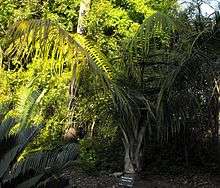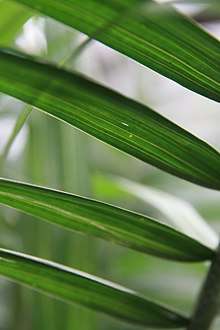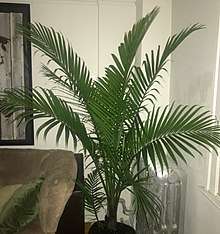Ravenea
| Majesty palm | |
|---|---|
 | |
| Ravenea rivularis | |
| Scientific classification | |
| Kingdom: | Plantae |
| Clade: | Angiosperms |
| Clade: | Monocots |
| Clade: | Commelinids |
| Order: | Arecales |
| Family: | Arecaceae |
| Tribe: | Ceroxyleae |
| Genus: | Ravenea C.D.Bouché |
| Synonyms[1] | |
| |
Ravenea (majesty palm) is a genus of 20 known species of palms, all native to Madagascar and the Comoros.[1]
They are small to large palms, with solitary, robust grey stems, swollen at base and gradually tapering upward. The species vary greatly in size, with R. hildebrandtii and R. nana only reaching 4 m, while R. robustior and R. sambiranensis both reach 30 m. The leaves are up to 2–5 m long, pinnately compound, reduplicate, erect at first then arching, twisted near the apex; with numerous crowded narrow ribbed leaflets. The inflorescence is short, borne among the leaves; the fruit is a red drupe.[2]. One particular species, Ravenea rivularis, is commonly cultivated as a houseplant and grown indoors all over the world. However, it's actually considered a vulnerable species in its wild habitat with fewer than 900 trees growing naturally.
- Species and Conservation Status
Endangered
Critically Endangered
Critically Endangered
Endangered
Vulnerable species
Endangered
Critically Endangered
Endangered
Endangered
Critically Endangered |
Critically Endangered
Critically Endangered Least Concern
Critically Endangered
Critically Endangered
Endangered
Vulnerable species
Near Threatened
Least Concern
Vulnerable species |
Most of the species are endangered. Species such as R. moorei are critically so, with only two specimens known, last seen in 1993 (IUCN report). R. louvelii is little better off, with fewer than 25 plants known (IUCN report). Overall, less than 50 trees of several species are still alive. Historical data indicates that populations are still decreasing for most, except for Ravenea sambiranesis and Ravenea madagascariensis. The species listed as critically endangered will most likely become extinct this century unless measures are taken to cultivate new trees and protect their habitats from being disrupted by deforestation and water pollution. Even if as few as a dozen trees of each species were planted on ideal, protected land where they could reproduce, it would give each species a much better chance for survival.
Cultivation and uses
Ravenea rivularis (Majesty Palm) is widely cultivated in subtropical regions, and it is sold commercially as a houseplant [3]. It is an adaptable palm that looks somewhat similar to the ever-popular Queen palm. It is a very large palm with a large, untidy crown. It has symmetrical leaves and develops an attractive swollen base of the trunk. Majesty palms prefer full sun, plenty of water, and high humidity to ensure healthy growth. It is tolerant of different soil types. Propagation is by seeds, which germinate in 2–3 months.

Majesty Palm as houseplant

Despite being sold often as a houseplant, usually at a very low price, Majesty palms do not make good indoor plants. They require frequent watering, fertilization, and high humidity to thrive. However, one may consider using an indoor humidifier and plant lamp/window which they will tolerate, provided they have a few months of hot outdoor weather. They prefer bright indoor light, but prefer shade when outdoors to prevent excessive water loss via transpiration. [4]
References
- 1 2 Kew World Checklist of Selected Plant Families
- ↑ Govaerts, R. & Dransfield, J. (2005). World Checklist of Palms: 1-223. The Board of Trustees of the Royal Botanic Gardens, Kew.
- ↑ Phillipson, P. 2017. Ravenea rivularis. The IUCN Red List of Threatened Species 2017: e.T38677A67737451. https://dx.doi.org/10.2305/IUCN.UK.2017-2.RLTS.T38677A67737451.en. Downloaded on 10 April 2018.
- ↑ Pland-care, Daily Professional Plant Tips You Can Use - Majesty Palm - Is it a House Plant or Indoor Palm?